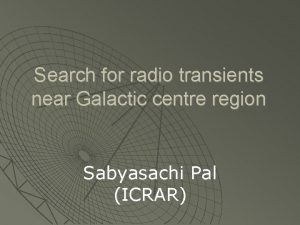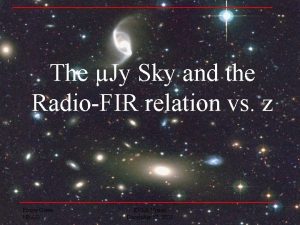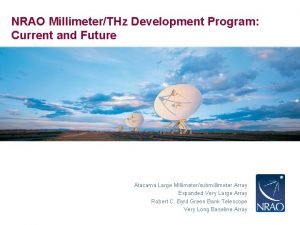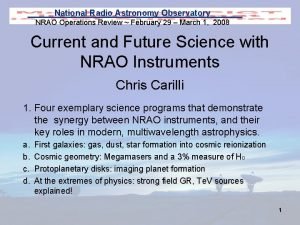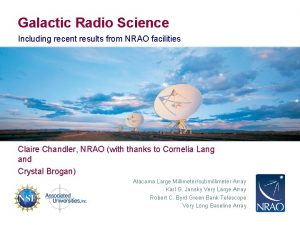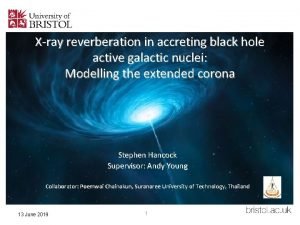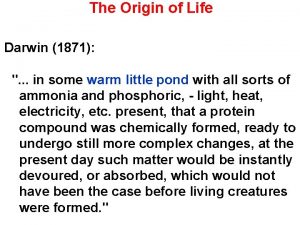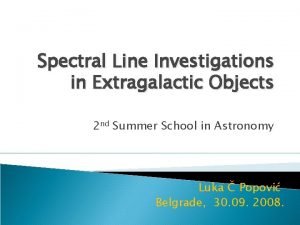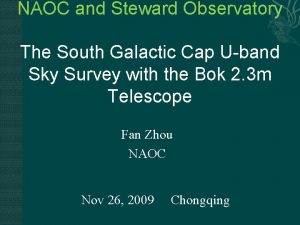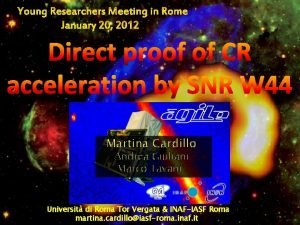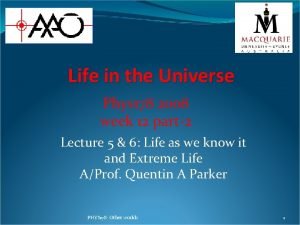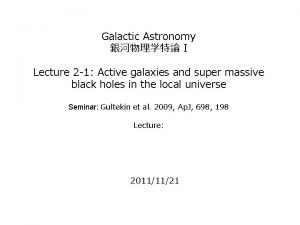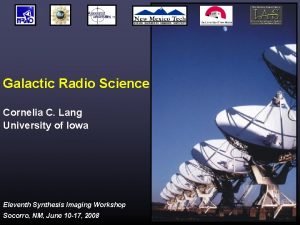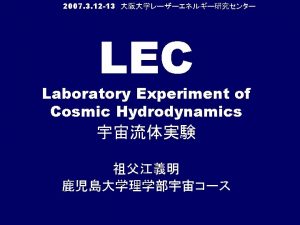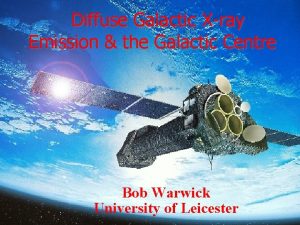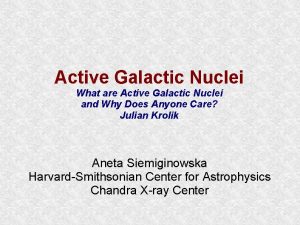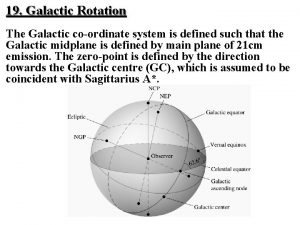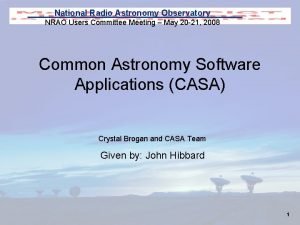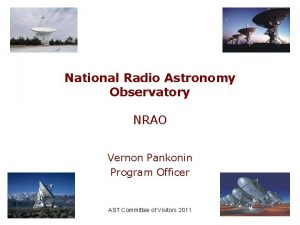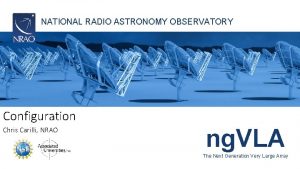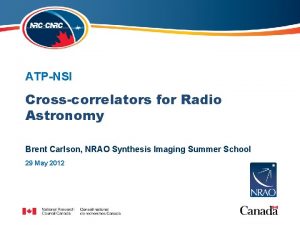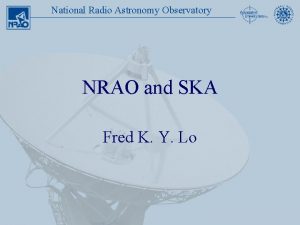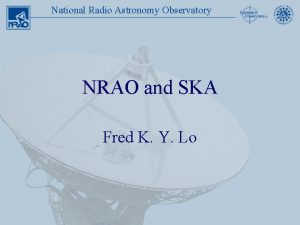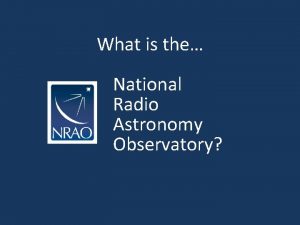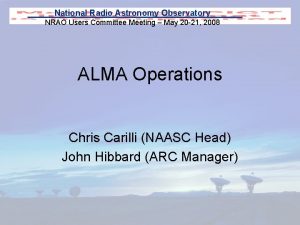Galactic Radio Science Including recent results from NRAO
































- Slides: 32

Galactic Radio Science Including recent results from NRAO facilities Claire Chandler, NRAO (with thanks to Cornelia Lang and Crystal Brogan) Atacama Large Millimeter/submillimeter Array Karl G. Jansky Very Large Array Robert C. Byrd Green Bank Telescope Very Long Baseline Array

Outline • What can we learn from radio emission – radio emission mechanisms with examples – Thermal and non-thermal continuum emission – Thermal and non-thermal spectral line emission – Considerations for observing galactic sources • A tour of selected galactic radio sources – Stellar birth – Stars – Stellar death – The interstellar medium 13 th Synthesis Imaging Workshop 2

Radio emission mechanisms • Synchrotron radiation – Non-thermal continuum process, arises from energetic charged particles spiraling (accelerating) along magnetic field lines – Emission spectral index ® energy distribution of electrons – Equipartition ® magnetic field strength – Polarization ® direction of magnetic field 13 th Synthesis Imaging Workshop 3

Synchrotron emission: SNRs • EVLA imaging of supernova remnants (Bhatnagar et al. 2011) Stokes I Spectra l index, a 13 th Synthesis Imaging Workshop 4

Radio emission mechanisms • Bremsstrahlung (free-free) emission – Thermal continuum process, arises from electrons being accelerated by ions in a plasma – Mass of ionized gas – Optical depth – Density of electrons in the plasma – Rate of ionizing photons 13 th Synthesis Imaging Workshop 5

Bremsstrahlung emission: Orion nebula Dust cloud located behind the HII region Orion nebula observed with 90 GHz camera on GBT (Dicker et al. 2009) Source I: Reid et al. (2007), Matthews et al. (2010) 13 th Synthesis Imaging Workshop 6

Radio emission mechanisms • Dust emission – Thermal continuum process, modified black-body emission from dust grains ~10 to ~ few 100 K – Spectrum of dust emissivity/opacity ® dust properties (grain size) – Dust temperature – Dust mass (assume a gas-to-dust ratio ® total gas mass) log S(n) n 3 -4 log n 13 th Synthesis Imaging Workshop 7

Dust emission: Fomalhaut No data ALMA Cycle 0 Reference Image 7 (870 μm) Band Dust Continuum Dust ring Location of Fomalhaut Coronagraph mask Scattered starlight No data 1. 5” x 1. 2” Boley et al. 2012 20 arcseconds ~ 150 13 Synthesis AU Imaging Workshop th 8

Continuum spectral index dus log S(n) ta ~3 • S(n) µ na • Measurement of spectral index, a, is key to interpreting the origin of the radio emission, and translating S(n) into physical properties of the source no nt thermal free-free a ~ 0. her 7 m 0. 1 al a ~~40 GHz log n 13 th Synthesis Imaging Workshop 9

Radio emission mechanisms • Spectral line emission: discrete transitions in atoms and molecules – Physical and chemical conditions of the gas (density, temperature) Molecular lines: – Kinematics (Doppler effect) CO, CS, H 2 O, – Zeeman effect ® B-field Si. O, CH 3 OH, – Masers NH , etc… 3 Atomic hydrogen: 21 cm “spinflip” transition Recombination lines: outer electronic transitions of H, He, C 13 th Synthesis Imaging Workshop 10

Spectral line emission: G 35. 03+0. 35 • WIDAR Tcorrelator enables many spectral lines to be observed at k ~ 30, 35, 220 K once – 16 x 8 MHz sub-bands covering: NH 3 (1, 1) – (6, 6), four CH 3 OH transitions, SO 2, HC 5 N DC 3 N, two RRLs, continuum 3. 6 μm 4. 5 μm 8. 0 μm 6. 7 GHz ✚ 44 GHz NH 3 (1, 1) – Cyganowski et al. (2009), Brogan et al. (2011) 13 th Synthesis Imaging Workshop 11

Considerations for proposing/observing • Need multi-frequency to determine a • Instrument sensitivity • Source structure! – Galactic sources range from point-like (stars, masers) to very extended (GMCs, SNRs) – match your science goals to your telescope/configuration • From the D to A configurations the VLA varies its angular resolution by a factor ~35 (depends on largest baseline/telescope separation) at a given frequency, reconfigures every ~4 months – The shortest baseline sets the largest angular scale measured – Compact configurations give less spatial resolution but better surface brightness sensitivity • ALMA will be continuously re-configuring its antennas • VLBA/VLBI has the highest spatial resolution of any ground-based observatory but requires very high surface brightness ® mostly nonthermal sources 13 th Synthesis Imaging Workshop 12

Galactic structure with the VLBA • Bar and Spiral Structure Legacy Survey (Be. SSe. L) project: use methanol and water masers in star-forming regions, along with exquisite astrometry from the VLBA, to map out the spiral structure of the Milky Way using trigonometric parallax – Probes obscured regions to far side of Galaxy • Results so far: – Milky Way 2 times more massive than previously thought – RO = 8. 3 kpc (vs. 8. 5 kpc) – ΘO= 239 km/s (vs. 220 km/s) – Previous values can yield kinematic distanced in error http: //www. mpifrby a factor of 2 bonn. mpg. de/staff/abrunthaler/ Be. SSe. L 13 th Synthesis Imaging Workshop 13

Stellar birth, death, and the ISM gravitational collapse Giant molecular clouds protostars wind …stellar evolution… ISM SNR Type II SN Main sequence stars clumping dissipation expansion ignition of thermonuclear burning wind dissipation PN + white dwarf …more stellar evolution… wind low mass high mass progenitor Red giants Long period variables (e. g. , Mira) instability to thermal pulses Horizontal branch, asymptotic giant branch stars

Star formation • Formation of massive stars, HII regions (Orion) • Formation of protoclusters (G 35. 03) • Formation of low-mass stars (examples on next slides) – Radio techniques vital for penetrating the dust that obscures star formation at optical/IR wavelengths, especially for the very young, deeply embedded sources – First showed that protostars have energetic winds and jets Þ mass loss • Formation of planetary systems (Fomalhaut) 13 th Synthesis Imaging Workshop 15

Low-mass star-formation: HH 211 • Collimated jet shows shocked H 2 emission (2. 2 mm) but protostar obsured in infrared, Si. O(1– 0) emission at 43 GHz traces jet closer to source • Swept-up molecular gas is traced by CO(2– 1) emission at 230 GHz and dense dust disk is detected in continuum emission (Chandler & Richer 2001) (Gueth & Guilloteau 1999) 13 th Synthesis Imaging Workshop 16

Low-mass star-formation: IRAS 162932422 • Band 9 (690 GHz) SV data from ALMA shows optically-thick dust continuum emission from source B, TB~150 K B A 13 th Synthesis Imaging Workshop 17

Stellar birth, death, and the ISM gravitational collapse Giant molecular clouds protostars wind …stellar evolution… ISM SNR Type II SN Main sequence stars clumping dissipation expansion ignition of thermonuclear burning wind dissipation PN + white dwarf …more stellar evolution… wind low mass high mass progenitor Red giants Long period variables (e. g. , Mira) instability to thermal pulses Horizontal branch, asymptotic giant branch stars

Radio emission from stars “Radio H-R Diagram” from Stephen White 13 th Synthesis Imaging Workshop 19

The Sun • Strongest radio source in the sky, at n > 100 MHz! • 5 Nov 2011, Type III burst – Electrons accelerated via magnetic reconnection, emit at plasma frequency, n µ ne ½ – Burst lasts < 100 ms – Location of peak emission from 1. 5 to 1. 0 GHz traces density gradient, reveals topology of B-field • Big flares can be associated with 10 s 100 s of bursts Chen et al. (in prep) 13 th Synthesis Imaging Workshop 20

Stellar birth, death, and the ISM gravitational collapse Giant molecular clouds protostars wind …stellar evolution… ISM SNR Type II SN Main sequence stars clumping dissipation expansion ignition of thermonuclear burning wind dissipation PN + white dwarf …more stellar evolution… wind low mass high mass progenitor Red giants Long period variables (e. g. , Mira) instability to thermal pulses Horizontal branch, asymptotic giant branch stars

The carbon-rich AGB star IRC+10216 • Spectroscopy and imaging at 1. 3 cm (K-band) • https: //science. nrao. edu/facilities/evla/early-science/demoscience 13 th Synthesis Imaging Workshop 22

Spectral movie of IRC+10216 • HC 3 N(4 -3) emission at 36. 4 GHz traces the expanding shell • Similar movies for HC 5 N(9 -8), HC 7 N(22 -21), Si. S(2 -1), reveal chemical structure of the envelope Si. S HC 3 N HC 5 N HC 7 N 13 th Synthesis Imaging Workshop 23

Stellar birth, death, and the ISM gravitational collapse Giant molecular clouds protostars wind …stellar evolution… ISM SNR Type II SN Main sequence stars clumping dissipation expansion ignition of thermonuclear burning wind dissipation PN + white dwarf …more stellar evolution… wind low mass high mass progenitor Red giants Long period variables (e. g. , Mira) instability to thermal pulses Horizontal branch, asymptotic giant branch stars

SS 433 and the W 50 nebula • 26 GHz emission from SS 433, 0. 095” (520 AU) resolution 13 th Synthesis Imaging Workshop 25

SS 433 and the W 50 nebula 13 th Synthesis Imaging Workshop 26

SS 433 and the W 50 nebula 13 th Synthesis Imaging Workshop 27

SS 433 and the W 50 nebula 13 th Synthesis Imaging Workshop 28

Stellar birth, death, and the ISM gravitational collapse Giant molecular clouds protostars wind …stellar evolution… ISM SNR Type II SN Main sequence stars clumping dissipation expansion ignition of thermonuclear burning wind dissipation PN + white dwarf …more stellar evolution… wind low mass high mass progenitor Red giants Long period variables (e. g. , Mira) instability to thermal pulses Horizontal branch, asymptotic giant branch stars

The ISM • Many applications of radio techniques to the interstellar medium – – Molecular clouds, chemistry, physics, structure Diffuse clouds (HI) Intercloud medium (HI+HII) Diffuse nebulae (Bremsstrahlung, RRLs) • Small-scale HI structures detected in absorption against extragalactic sources: VLBA provides spatial resolution of a few AU! Local bubble ~100 pc Cold HI scale height (2 z) ~200 pc (C. Brogan) 13 th Synthesis Imaging Workshop 3 C 138 30

HI absorption toward 3 C 138 • Multi-epoch VLBA observations, 1995, 1999, 2002 • Resolution 20 mas = 10 AU at 500 pc • Changes in t indicate changes in density of intervening Galactic atomic gas, sizescale of features ~25 AU (Brogan et al. 2005) 13 th Synthesis Imaging Workshop 31

Summary • Radio interferometry is a powerful tool for investigating Galactic sources – Especially important in the Galactic Plane, where extinction is a problem at other wavelengths – Provides insight into all phases of stellar evolution and the interstellar medium – Spatial resolution comparable to (or better than!) other wavelengths ® enables multi-wavelength approach to solving science problems on matched spatial scales • New capabilities coming online ®Expande opportunity for you! CARMA d VLA ALMA LOFAR LWA SMA 13 th Synthesis Imaging Workshop 32
 Galactic centre radio transients
Galactic centre radio transients A friend emails you the results of a recent high school
A friend emails you the results of a recent high school Nrao
Nrao Nrao
Nrao Nrao
Nrao Nrao
Nrao Nrao pst
Nrao pst Trunked radio vs conventional radio
Trunked radio vs conventional radio Galactic headquarters map
Galactic headquarters map Sub saharan african city model
Sub saharan african city model Swcombine factions
Swcombine factions Urban structure models
Urban structure models Galactic city model
Galactic city model Active galactic nuclei
Active galactic nuclei Galactic habitable zone
Galactic habitable zone Active galactic nuclei
Active galactic nuclei Galactic phonics ure
Galactic phonics ure Galactic cap review
Galactic cap review Alessandro cardillo
Alessandro cardillo Galactic habitable zone
Galactic habitable zone Active galactic nuclei
Active galactic nuclei Galactic
Galactic My favourite science
My favourite science Recent trends in ic engine
Recent trends in ic engine Recent developments in ict
Recent developments in ict Recent developments in object detection
Recent developments in object detection Is college worth it synthesis essay
Is college worth it synthesis essay Explain the recent trends of india's foreign trade
Explain the recent trends of india's foreign trade Reading scanning
Reading scanning Recent trends in project management
Recent trends in project management Recent demographic changes in the uk
Recent demographic changes in the uk Myipsclever
Myipsclever During a recent police investigation
During a recent police investigation
